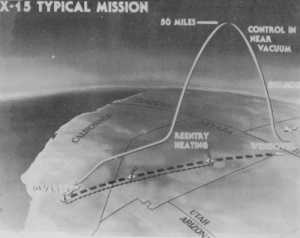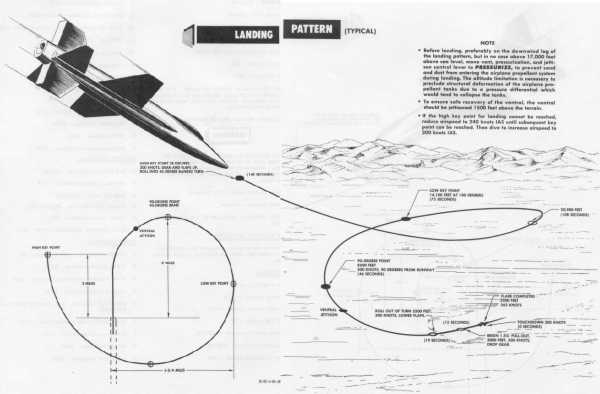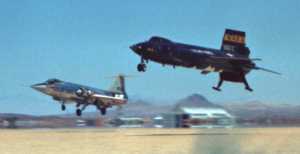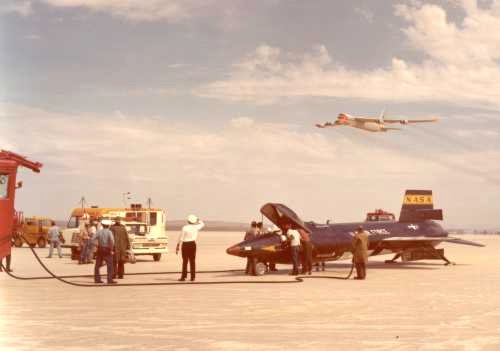X-15 pilot
report, part 4:
X-15 Flight: Flying the Mission and
Returning

After you light the torch you need to fly precisely in the face of
some unusual challenges. Let's say the mission at hand is a more or
less full
bore altitude flight.
Part 1 is to go to full throttle and pull up to just the right climb
attitude. With 57,000 pounds
of thrust from the rocket, maybe even 60,000 on a good day, you start
at 2 G's acceleration while your tanks are full and your gross weight
is about 33,000 pounds. As you burn fuel and oxidizer, with weight
dropping to barely over 15,000 pounds, acceleration doubles to 4 G's.
Rocket
motor performance can vary depending on lots of factors that sound
small,
but sometimes they add up instead of cancelling each. If you compound
that
deviation by missing your planned climb attitude by as little as 1
degree, the results begin to look astronomical. Flying with precision
that would
give most pilots enormous pride, your imprecision can easily produce a
30,000 foot overshoot or undershoot in maximum altitude.
With 57,000 pounds
of thrust from the rocket, maybe even 60,000 on a good day, you start
at 2 G's acceleration while your tanks are full and your gross weight
is about 33,000 pounds. As you burn fuel and oxidizer, with weight
dropping to barely over 15,000 pounds, acceleration doubles to 4 G's.
Rocket
motor performance can vary depending on lots of factors that sound
small,
but sometimes they add up instead of cancelling each. If you compound
that
deviation by missing your planned climb attitude by as little as 1
degree, the results begin to look astronomical. Flying with precision
that would
give most pilots enormous pride, your imprecision can easily produce a
30,000 foot overshoot or undershoot in maximum altitude.
All that precise flying happens on the gages. Let's say today's
mission profile puts you in a climb attitude of 42 degrees. If you
glance out the windows in this attitude you see nothing but dark blue
sky that's quickly getting blacker as you climb. With no visual cues
and thrust overpowering gravity your sense of balance lies -- it feels
as if when you pulled up
the rotation never stopped and you've gone past vertical, to an
inverted
attitude! Those instruments connected to the gyro-stabilized inertial
platform
are what you need to believe to stay in touch with reality.
 As you climb out
of the atmosphere the aerodynamic flight controls lose their
effectiveness. Here you have to transition from flying with the right
hand side stick (and rudder pedals) to flying with the left-hand side
stick, for the hydrogen peroxide thrusters. That's unless you have the
luxury of flying the #3 X-15 -- its adaptive controller, the MH-96,
lets you use only a single side stick and automatically blends
aerodynamic controls and reaction controls.
As you climb out
of the atmosphere the aerodynamic flight controls lose their
effectiveness. Here you have to transition from flying with the right
hand side stick (and rudder pedals) to flying with the left-hand side
stick, for the hydrogen peroxide thrusters. That's unless you have the
luxury of flying the #3 X-15 -- its adaptive controller, the MH-96,
lets you use only a single side stick and automatically blends
aerodynamic controls and reaction controls.
On today's altitude flight either you cut the engine after an 82
second burn or the X-15 burns exhaust enough ammonia and LOX to burn
out by then without your help. That's another variable that makes a big
difference in peak altitude, if you have power on for an extra second
you can expect a sizeable
overshoot. Now you're weightless, still climbing in a ballistic arc. In
a
couple minutes today's flight tops out at about 300,000 feet over the
high deserts of Nevada and southern Califoria.
 As you pitch
over you can now catch a spectacular view of the southwest
U.S. The view shown here is the Colorado River Valley from 210,000
feet.. In the words of Robert White, "My flights to 217,000 feet and
314,750 feet were very dramatic in revealing the earth's curvature ... at my highest altitude I could turn my head
through a 180º arc and wow! - the earth is really round. At my peak altitude I was roughly
over the Arizona/California border in the area of Las Vegas, and this
was how I described it: looking to my left I felt I could spit
into the Gulf of California. Looking to my right I felt I could
toss a dime into San Francisco Bay." If the coast is clear that
far north, you can just about make out Puget Sound, nearly a thousand
miles away..
As you pitch
over you can now catch a spectacular view of the southwest
U.S. The view shown here is the Colorado River Valley from 210,000
feet.. In the words of Robert White, "My flights to 217,000 feet and
314,750 feet were very dramatic in revealing the earth's curvature ... at my highest altitude I could turn my head
through a 180º arc and wow! - the earth is really round. At my peak altitude I was roughly
over the Arizona/California border in the area of Las Vegas, and this
was how I described it: looking to my left I felt I could spit
into the Gulf of California. Looking to my right I felt I could
toss a dime into San Francisco Bay." If the coast is clear that
far north, you can just about make out Puget Sound, nearly a thousand
miles away..
Coming back down you carefully establish the correct attitude for
reentry into the atmosphere as a very fast glider with a truly crummy
glide performance. REAL gliders are painted white to help them keep
cool, by reflecting solar energy. The X-15 is painted black to help it
keep cool, by radiating the
heat that builds up rapidly from air friction. A few parts of the nose,
wings, and stabilizers briefly hit temperatures up to 1,200 degrees and
glow red hot during reentry.
Pulling out of the reentry is one of the maneuvers that lets the
pilot know this is no ordinary realm of flight. If this altitude
flight
topped out at 350,000 feet you can expect to be coming out of reentry
at
Mach 5.4 in a 40-degree nose-down attitude. Pulling out of this
dive
requires pulling an average of 5 g's for about 20 seconds. If you
only
need to turn through a mere 10-degree heading change at Mach 5.3,
expect
to pull 3 g's for 20 seconds.
There are a few unusual but modest control couplings. At low angles
of attack, roll inputs couple to a favorable yaw.. Above mach 2.6, roll
response gets quicker as angle of attack increases. At least
that's what the manual says -- Scott Crossfield reports that there's
virtually no roll/yaw coupling, she rolls nicely.
As the X-15 slows down and drops, stability degrades and allowed yaw
angles decrease. Below about 40,000 feet and mach 0.5, minimum control
speed is determined
by stability; above that point it's governed by buffeting at the tail.
Stability
margins allow you to fly AOA's up to 20 degrees, but the pre-stall
buffet
starts at 13 degrees.
Stability problems can be evil. Conventional wisdom says that you're
NEED the electronic stability augmentation systems (or the SAS
functions built into the MH-96) or your chances for a survivable
reentry are puny. Hypersonic stability trouble can bite in big ways,
including the sort of inertia coupling that earlier killed Mel Apt in
the X-2.
Going back to being a glider approaching the landing pattern, expect
a sink rate of about 150 feet per second (9,000 fpm) at mach 0.75. That
gives a max L/D of almost 5:1 at 40,000 feet, but realistically you can
expect closer
to 4:1.
Finally, you have to land at Edwards Air Force Base. Field elevation
is 2,200 feet for a somewhat groomed runway on the dry lake bed.
Approach will be sort of a 360 overhead pattern; it'll actually be a
tightening spiral because
true airspeed drops while you descend at a constant indicated airspeed.

Landmarks in the pattern on this flight are:
145 seconds to touchdown, 28,900 feet: High key point
This is 2 miles short of the approach end of the runway and
1.5 miles to its right. You should hit it at 300 knots and roll into a
45-degree banked turn to the left. You'll maintain 300 knots IAS and
the 45-degree bank
until just before you flare.
108 seconds to touchdown, 20,900 feet:
270-degree key point: "Crosswind leg",
90-100 seconds to touchdown, below 17,000 feet:
Pressurize the propellant tanks. They were switched to Vent
at burnout, but they need pressure now for two reasons:
- To prevent sand and dust at low altitudes from entering the
tanks
through their vents.
- To keep the tanks from collapsing. The vents may not keep up
with the rapid change in ambient pressure at low altitude.
75 seconds to touchdown, 14,100 feet:
Low key point, "downwind abeam" (opposite approach end of
runway, about 3 3/4 miles from it).
46 seconds to touchdown, 8,500 feet:
90-degree key point, "base leg".
30 seconds to touchdown, 5,500 feet:
Jettison the ventral.
19 seconds to touchdown, 3,500 feet:
Roll out onto the runway heading and drop the flaps. You're
still at 300 knots.
15 seconds to touchdown, 3,000 feet:
Drop the gear and begin to flare. The flare is a 1.5 G
pullout.
8 seconds to touchdown, on the deck, just above 2,200 ft field
elevation:
End of flare; airspeed's dropping through 262 knots.
0 seconds:
Set it down when airspeed drops to 200 knots and ride until
you stop. With no brakes and no steering, you're almost a passenger
now.
Well, not entirely. You can actually steer a little bit by using
the stick as if you're banking: The stabilators will shift weight from
one landing skid to the other and will steer you in the direction
you've moved the stick while you're fast enough. When the speed
drops off, force generated by the stabilators drop too, and you do
finish the rollout as a non-steering passenger.
Finally, go through the after-landing checklists to secure
everything. As the B-52 offers its salute with a flyby, convince
the folks on the ground and the ones who get out of the chase planes
that a modest celebration is in order. Or maybe a big
celebration, this flight may well have been another milestone in
aviation history.

This pilot report is split into these four parts:
1. X-15 General
Description & Walkaround
2. X-15 Cockpit Check
3. X-15
Flight:
Heading Out to Launch
4. X-15
Flight:
Flying the Mission and Returning
Related to all four sections:
Photo credits
and pointers to related resources
Send questions and comments on the SierraFoot X-15 pages to Paul Raveling.
Return to X-15
pilot report root page X-15
home page SierraFoot
site home page
 With 57,000 pounds
of thrust from the rocket, maybe even 60,000 on a good day, you start
at 2 G's acceleration while your tanks are full and your gross weight
is about 33,000 pounds. As you burn fuel and oxidizer, with weight
dropping to barely over 15,000 pounds, acceleration doubles to 4 G's.
Rocket
motor performance can vary depending on lots of factors that sound
small,
but sometimes they add up instead of cancelling each. If you compound
that
deviation by missing your planned climb attitude by as little as 1
degree, the results begin to look astronomical. Flying with precision
that would
give most pilots enormous pride, your imprecision can easily produce a
30,000 foot overshoot or undershoot in maximum altitude.
With 57,000 pounds
of thrust from the rocket, maybe even 60,000 on a good day, you start
at 2 G's acceleration while your tanks are full and your gross weight
is about 33,000 pounds. As you burn fuel and oxidizer, with weight
dropping to barely over 15,000 pounds, acceleration doubles to 4 G's.
Rocket
motor performance can vary depending on lots of factors that sound
small,
but sometimes they add up instead of cancelling each. If you compound
that
deviation by missing your planned climb attitude by as little as 1
degree, the results begin to look astronomical. Flying with precision
that would
give most pilots enormous pride, your imprecision can easily produce a
30,000 foot overshoot or undershoot in maximum altitude. 




